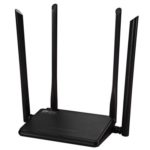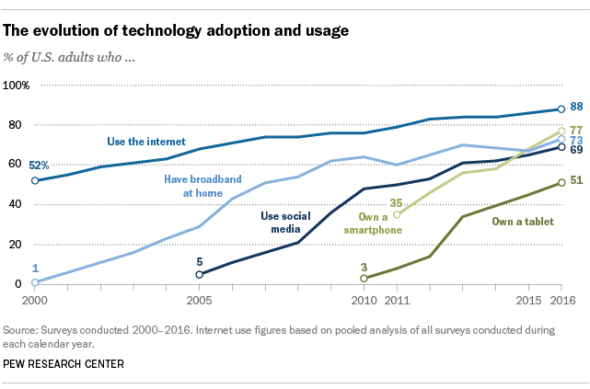 U.S. smartphone ownership and the percentage of U.S. households with broadband service rose in 2016, reaching record levels of 77 and 73 percent, respectively as of November, according to the latest data from the Pew Research Center.
U.S. smartphone ownership and the percentage of U.S. households with broadband service rose in 2016, reaching record levels of 77 and 73 percent, respectively as of November, according to the latest data from the Pew Research Center.
Pew’s release of the first of what is to be a regular series of continually updated fact sheets regarding information and communications technology (ICT) also reveals that 88 percent of Americans now use the Internet. That’s up from 52 percent in 2000, when the independent, non-profit research organization began tracking Internet usage.
Smartphone penetration rates continue to be highest among young adults, 92 percent of whom own smartphones. A “sharp uptick” in the number of low-income and older Americans (50-plus) that own smartphones was one of 2016’s most notable tech trends, however, Pew Associate Director of Research Aaron Smith highlights in a Jan. 12 blog post.
Nearly three-quarters of Americans 50-64 (74%) owned smartphones as of November 2016, according to Pew’s latest available market data. That’s up 16 points from 2015.
Smartphone ownership in households with overall annual incomes less than $30,000 rose 12 points from 2015, to 64 percent. The corresponding percentage for those 65 and older rose 12 points to 42 percent.
From a longer term perspective, U.S. smartphone ownership has increased from 35 percent in 2011, when Pew first began tracking data, to 77 percent as of last November.

Broadband Trends
A rebound in the share of American households with broadband service is the second of four notable 2016 tech trends that Smith highlights. The percentage of U.S. broadband households declined slightly between 2013-2015, from 70 to 67 percent.
That rose to 73 percent as of last November, the highest level since Pew began tracking home broadband adoption in 2000. Gains have been skewed toward those with higher levels of education and incomes, however.
Home broadband is present in 34 percent of households of Americans who haven’t graduated high school. It’s present in 91 percent of those in which college graduates live. Home broadband adoption also varies by age, location, racial and ethnic background, as well as household income, Smith points out.
Furthermore, more Americans without broadband at home relied on their smartphones for Internet access. Twelve percent of those responding to Pew surveys said they were “smartphone dependent.” That’s up 4 points since 2013.
Smartphone reliance, moreover, is markedly higher among young adults, non-whites and those who live in low-income households.
The rapid rise in social media use and tablet ownership are the third and fourth most notable trends that Smith singles out.
Just 5 percent of Americans used social media when Pew began tracking usage in 2005. That had risen to 69 percent last November. As has been well documented, social media usage is highest among young adults (18-29), 86 percent of whom use it.
A large majority of those 30-49 (80%) and 50-64 (64%) use social media as well. Only about one-third (34%) of Americans 65 and older do so, but that’s up from around 1 in 10 as recently as 2010.
Smith also highlights the rapid rise in tablet adoption, which continued, though at a slower pace, in 2016. Just 3 percent of Americans reported owning some type of tablet for Pew’s 2010 survey. That had risen to 51 percent as of November 2016.
